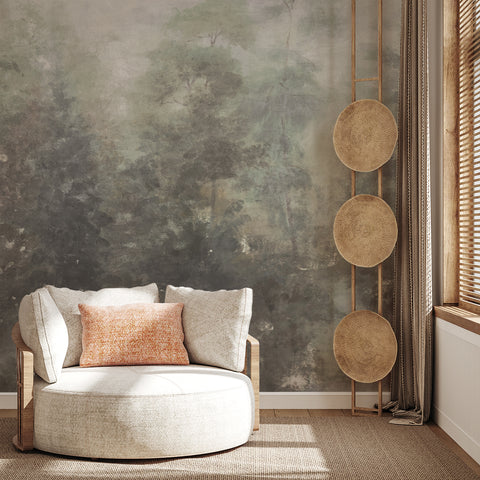Peel and stick wall murals are a popular choice for home decor due to their ease of application and stunning visual impact. However, maintaining their beauty requires proper cleaning techniques. Improper cleaning can lead to damage, reducing the mural’s lifespan and aesthetic appeal. This article will guide you through the steps to safely clean your peel and stick wall mural without causing damage.
II. Understanding Your Wall Mural Material
Before you start cleaning, it’s crucial to understand the material of your wall mural. Different materials require different cleaning methods. Here are some common materials used in peel and stick wall murals:
- Vinyl
- Fabric
- Non-woven
- Cellulose
- Bamboo
- Hybrid
- Fiberglass
Knowing your mural’s material will help you choose the right cleaning method and avoid potential damage.
III. Initial Preparation
A. Dusting the Mural
Tools Needed:
- Soft duster
- Vacuum with brush attachment
Step-by-Step Dusting Process:
- Use a soft duster to gently remove loose dust from the mural’s surface.
- For stubborn dust, use a vacuum with a brush attachment. Move the brush in gentle, sweeping motions.
B. Testing Cleaning Solutions
Before applying any cleaning solution, it’s essential to test it in an inconspicuous area to ensure it doesn’t damage the mural.
How to Perform a Patch Test:
- Apply a small amount of the cleaning solution to a hidden corner of the mural.
- Wait for 24 hours to observe any adverse reactions.
- If there’s no damage or discoloration, proceed with cleaning the entire mural.
IV. Sensitive Cleaning Methods
A. Using a Dry Cloth
Suitable Materials:

-
- Cellulose
- Fabric
- Bamboo
- Hybrid
- Removable peel-and-stick
- Non-woven
- Vinyl
- Fiberglass
Step-by-Step Instructions:
- Use a soft, dry cloth to gently wipe the mural’s surface.
- Move in circular motions to lift dirt without applying too much pressure.
B. Using a Soft Sponge with Water
Suitable Materials:
- Fabric
- Cellulose
- Bamboo
- Peel-and-stick
- Non-woven
- Vinyl
- Fiberglass
- Hybrid
Step-by-Step Instructions:
- Dampen a soft sponge with water. Ensure it’s not soaking wet.
- Gently wipe the mural’s surface in circular motions.
- Use a dry cloth to pat the area dry.
V. Deep Cleaning Methods
A. Using a Mild Detergent Solution
Suitable Materials:
- Vinyl
- Cellulose
- Fiberglass
- Premium non-woven
- Hybrid
Step-by-Step Instructions:
- Mix a few drops of mild detergent with water.
- Dampen a soft sponge with the solution.
- Gently clean the mural’s surface in circular motions.
- Rinse the sponge with clean water and wipe the mural again to remove any detergent residue.
- Pat the area dry with a soft cloth.
B. Using a Vinegar Solution
Suitable Materials:
- Vinyl
- Cellulose
- Fiberglass
- Hybrid
Step-by-Step Instructions:
- Mix equal parts of white vinegar and water.
- Dampen a soft sponge with the solution.
- Gently clean the mural’s surface in circular motions.
- Rinse the sponge with clean water and wipe the mural again to remove any vinegar residue.
- Pat the area dry with a soft cloth.
VI. Cleaning Tips and Best Practices
A. Avoiding Excess Moisture
Risks of Oversaturation:
- Excess moisture can seep behind the mural, causing it to peel or bubble.
Proper Wringing Techniques:
- Always wring out your sponge or cloth thoroughly before cleaning.
- Ensure it’s damp, not wet.
B. Using Soft Materials
Recommended Tools:
- Soft cloths
- Sponges
- Brushes
Avoiding Abrasive Materials:
- Never use abrasive sponges or brushes as they can scratch and damage the mural’s surface.
C. Proper Drying Techniques
Importance of Thorough Drying:
- Proper drying prevents moisture from causing damage or mold growth.
Methods:
- Air drying: Allow the mural to air dry naturally.
- Patting with a soft towel: Gently pat the mural with a soft towel to absorb excess moisture.
VII. Common Mistakes to Avoid
A. Using Harsh Chemicals
Potential Damage:
- Harsh chemicals can strip the mural’s color and damage its surface.
Recommended Alternatives:
- Use mild detergents or natural solutions like vinegar and water.
B. Cleaning Under Direct Sunlight
Risks:
- Direct sunlight can cause streaking and uneven drying.
Best Practices:
- Clean the mural in shaded areas or du browse around here ring times when sunlight is not directly hitting it.
VIII. Maintaining Your Wall Mural
A. Regular Inspections
Checking for Minor Damages:
- Regularly inspect your mural for any signs of damage, such as peeling or bubbling.
- Address minor issues promptly to prevent them from worsening.
B. Environmental Controls
Managing Humidity, Direct Sunlight, and Temperature Fluctuations:
- Keep the room’s humidity levels in check to prevent moisture damage.
- Avoid placing the mural in direct sunlight to prevent fading.
- Maintain a stable room temperature to avoid expansion and contraction of the mural material.
C. Periodic Cleaning Schedule
Recommended Frequency:
- Dust the mural weekly to prevent dirt buildup.
- Perform a deep cleaning every few months or as needed.
IX. Conclusion
Proper cleaning and maintenance are essential to keep your peel and stick wall mural looking its best. By following the steps and tips outlined in this article, you can ensure your mural remains vibrant and damage-free for years to come. Remember to always test cleaning solutions, use gentle materials, and avoid common mistakes. Share your personal tips and experiences in the comments below!

Meet Hi there! I’m Jason Noon, a passionate Product Consultant specializing in mural design and customization. Welcome to MuralMoxie, where creativity meets craftsmanship. My journey into the world of murals began over a decade ago. I started as a graphic designer, but my love for large-scale art installations quickly took over.



